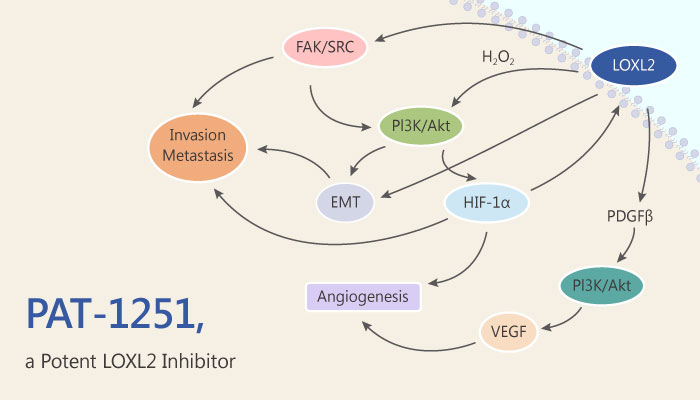Fibrosis is a formation of excess fibrous connective tissue in body, similar to scarring. They are involved in stimulated fibroblasts depositing connective tissue. Fibrosis occurs in various tissues of the body, such as lung, liver, heart, and brain. Most fibrosis causes inflammation or body damage.
As is known to all, lysyl oxidase homolog 2 (LOXL2) belongs to the lysyl oxidase family, the copper-dependent amine oxidases. LOXL2 has several bioactivities. It crosslinks collagen type IV, affects the sprouting of new blood vessels. Besides, the protein exhibits high levels in certain cancer cells. Furthermore, LOXL2 plays a vital role in fibrotic diseases. It is up-regulated in fibrotic diseases.
Therefore, inhibition of LOXL2 may become hot spot to treat fibrosis.

In recent years, researchers found out several compounds as LOXL2 inhibitors. Martin W. Rowbottom, et al discovered compound 43 is the most promising one, with the name of PAT-1251.
On one hand, PAT-1251 is a potent, selective, irreversible and oral LOXL2 inhibitor. It shows an IC50 of 0.71 μM for human LOXL2. What’s more, it exhibits no obvious species difference, with IC50s of 0.10, 0.12, and 0.16 μM for mouse, rat, and dog LOXL2, respectively. In addition, PAT-1251 less actively inhibits hLOXL3 activity, the IC50 value is 1.17 μM.
On the other hand, PAT-1251 displays a moderate inhibitory effect on CYP450. The IC50s are 1.8, 1.7, 2.4, 12, and 30 μM against 1A2, 2C9, 2C19, 2D6, and 3A4, respectively. However, PAT-1251 is ineffective on hERG.
Considering the great efficacy of PAT-1251 on LOXL2, researchers have to do further study to explore its potential in treating fibrosis.
Reference:
1. Rowbottom MW, et al. J Med Chem. 2017 May 25;60(10):4403-4423.